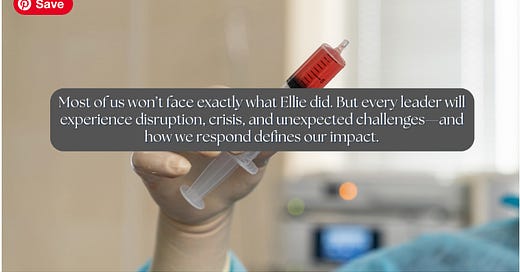Leading Through the Unthinkable
A Crisis-Tested Blueprint for Resiliency When Our Personal Life Collides with Work
Leadership isn’t tested in times of ease. It’s tested in the moments that threaten to break us.
AUTHOR’S NOTE: This is one of my resilient leadership editions, which started on LinkedIn. I interview professionals about how they manage personal crises while leading others. Sometimes the balance can feel impossible, but when we can share our authentic and honest stories with others, we make everything seem more possible.
I first met Ellie McLaughlin a few years ago when she walked into my retail store. She had an air of quiet confidence—steady, poised, present. We got to talking, and before long, she shared a story that changed how I think about resilience and leadership.
A Parent’s Worst Fear Becomes a Woman’s Defining Moment
In 2018, Ellie’s son, Patrick, was an active tenth grader—an athlete, full of energy, until he wasn’t. He started sleeping more. Exhaustion replaced enthusiasm. A routine doctor’s visit turned into an urgent hospital referral. Then came the words no parent is prepared to hear.
"We need you to go to the hospital. Immediately."
The initial fear was leukemia. Tests later confirmed it was severe aplastic anemia—a rare and life-threatening condition. Patrick’s bone marrow was shutting down. His body wasn’t producing blood cells, leaving him defenseless against infection, bruising, or even minor cuts. The road ahead would be long, unpredictable, and utterly consuming.
At the time, Ellie was the Director of People + Culture at a business advisory firm. She had teams to lead, strategies to execute, and deadlines to meet. But suddenly, none of that mattered more than the fight to save her son’s life.
Yet, instead of retreating from her professional responsibilities, Ellie transformed the crisis into a crisis-tested leadership blueprint—one that applies to anyone navigating personal hardship while leading a team.
“I realized it’s okay to step away from work when you need to. You must establish priorities and boundaries, and in my case, Patrick’s care was the priority.”
The Crisis-Tested Blueprint for Resilient Leadership
Ellie’s journey revealed three key strategies that every leader can apply when navigating unexpected crises:
1️⃣ Adapt Quickly: Prioritize What Truly Matters
The best leaders don’t try to do everything—they focus on what matters most and give themselves permission to step back when needed.
Ellie shifted to remote work from the hospital, ensuring she was present for Patrick while empowering her team to step up.
She delegated more effectively, trusting her team rather than micromanaging.
She set clear boundaries between work and caregiving—knowing that real leadership includes knowing when to step away.
How to apply this lesson:
Assess your priorities. In moments of crisis, ask: What is absolutely essential right now? What can wait?
Empower your team. Delegate responsibilities so others can step up while you focus on what matters most.
Give yourself permission to step back. Leadership doesn’t mean doing it all—it means making strategic choices in difficult moments.
2️⃣ Lean on Community: The Power of “Unity in Community”
Ellie’s self-proclaimed mantra, “Unity in Community,” became her guiding principle.
She accepted help from friends, family, and colleagues instead of trying to handle everything alone.
She didn’t just receive support—she became an advocate, joining the Dana-Farber Cancer Institute's Pediatric Parent Advisory Council (PFAC) to improve hospital experiences for teenage patients. There, she helped ensure that adolescent patients had more age-appropriate resources, proving that leadership isn’t just about managing crises—it’s about using them to create change.
How to apply this lesson:
Build your support network before you need it. Strong leaders cultivate relationships so they have people to lean on when challenges arise.
Ask for (and accept) help. Leadership isn’t about doing it alone—it’s about knowing when to seek support from colleagues, mentors, and friends.
Turn hardship into impact. Like Ellie, look for ways to use personal challenges to improve systems and support others in similar situations.
3️⃣ Lead with Honesty: Transparent Leadership Builds Trust
Ellie knew she couldn’t pretend everything was fine—so she led with transparency and empathy.
She was upfront with her team, sharing just enough about her situation to set expectations and create a culture of understanding.
She demonstrated vulnerability as a strength, fostering a high-trust environment where her team felt valued and engaged.
Research from Adam Grant shows that high-trust teams outperform low-trust teams by up to 50%, making transparency a business advantage, not just a personal choice.
How to apply this lesson:
Communicate openly. Share challenges with your team in a way that sets expectations while maintaining professionalism.
Model resilience without toxic positivity. It’s okay to acknowledge struggles without pretending everything is fine.
Create a culture of trust. When leaders are honest about their challenges, teams feel safer, more engaged, and more willing to step up.
Patrick’s Legacy and Ellie’s Leadership Today
Today, Patrick is thriving. Ellie continues to lead with the same grace, resilience, and authenticity that carried her through one of the hardest seasons of her life.
Her story is more than just an inspiring personal journey—it’s a blueprint for leaders facing their own storms.
✅ Adapt Quickly – Prioritize what matters and empower your team.
✅ Lean on Community – “Unity in Community” isn’t just a tagline, it’s a strategy.
✅ Lead with Honesty – Transparency and trust fuel strong leadership.
True leadership isn’t about avoiding challenges—it’s about navigating them with clarity, courage, and connection.
So, what’s your crisis-tested leadership blueprint? How have you navigated personal hardship while leading a team?
I’d love to hear from you in the comments, or if you'd like to share your detailed story with ITIFH readers, please reach out to be considered for an upcoming edition. Thank you for sharing your story to help others.
Learn more about the NMDP's Bone Marrow Registry Program that saved Patrick's life.





